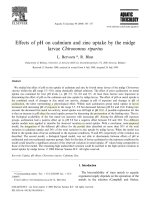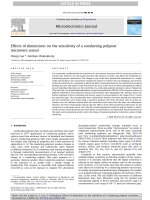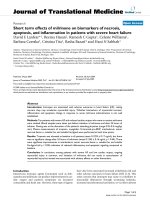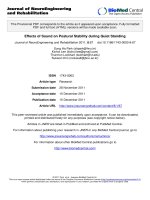Effects of temperature on enzyme catalyzed reactions doc
Bạn đang xem bản rút gọn của tài liệu. Xem và tải ngay bản đầy đủ của tài liệu tại đây (891.72 KB, 18 trang )
Effects of temperature on
enzyme catalyzed reactions
Lecturer: Msc. Le Hong Phu
GROUP’S MEMBER
•
Trần Lê Đan Hà BT070026
•
Mã Bích Như BT070153
•
Tô Bảo Châu BT070011
•
Lê Phương An BT070004
•
Bùi Nhất Tiên BT070079
CONTE NT
Introduction
Effects of temperature on enzyme-catalyzed
reactions
Example and Application
Conclusion
•
Living processes consists almost entirely of biochemical
reactions. Without catalysts these reactions would not occur
fast enough to sustain life.
How does an enzyme
do this?
> because enzyme
is a catalytic protein-a
chemical agent that
changes the rate of a
reaction without being
consumed by the
reaction
Introduction about enzyme-catalyzed
reaction.
Optimal temperature of human enzyme is about 35-40ºC, of
bacteria is about 70ºC or higher
Factor effects on enzyme-catalyzed
reaction
Fig 1. 32. Examples of
interactions contributing to
the tertiary structure of a
protein.
Hydrophobic side chains
usually end up in the interior
of a protein, away from
water. Along with this
clustering of hydrophobic
groups, misleadingly called
hydrophobic interactions,
hydrogen bonds, ionic
bonds, and van der Waals
interactions are all weak
interactions (weak bonds)
between side chains that
collectively hold the protein
in a specific conformation.
Much stronger are the
disulfide bridges, covalent
bonds between the side
chains of two cysteine amino
acids. This diagram shows
only one small part of a
hypothetical protein.
Low temperatures slow the
rate of formation of the
enzyme-substrate complex
because the molecules move
at slower speeds and so do
not come in contact with one
another as frequently.
As the temperature rises, the
substrate and enzyme molecules
vibrate more and they have a higher
chance of coming together (collision)
to form an E-S-complex. Therefore the
rate of enzyme reaction increases. As
the reaction temperature (), enzyme
activity also increases ().
Factor effects on enzyme-catalyzed
reaction
At the optimum temperature,
the rate of enzymatic reaction is
at a maximum The enzyme works
best because substrates collide
with active sites more frequently
when the molecules
move rapidly
At temperature higher than
the optimum, the reaction
becomes inhibited as the
enzyme molecule vibrates too
much and the shape of the
active site becomes unfit for
the substrate.
At extreme temperature,
enzyme molecule, being
protein, has its shape
permanently changed. The
active site does not fit the
substrate, the enzyme is
denatured. The reaction rate is
zero.
When enzymes are heated up too much, they vibrate so vigorously that the bonds holding the protein
structure in its specific shape becomes broken. The enzyme shape changes and the substrate no
longer fits in to the active site.
the enzyme can become denatured and lose all function
Example
Effects on enzyme performance
•
Catechol oxidase is an enzyme that produces a
colored compound from a colorless precursor in
fruits and vegetables.
•
The browning is caused by a reaction between
catechol and oxygen.
•
Benzoquinone has brown colour.
Experiment
Tube 1
Tube 2 Tube 3 Tube 4 Tube 5
10 ml Water 10 ml Water 10 ml Water 10 ml Water 10 ml Water
Cut-up Potato Cut-up Potato Cut-up Potato Cut-up Potato
5 ml Catechol 5 ml Catechol 5 ml Catechol 5 ml Catechol 5 ml Catechol
Room Temp 100°C Room Temp. 0°C 40°C
Observation
Application
•
Temperature has an important role in
industry, agriculture, biomedical and many
fields in life.
•
Depending on the optimal temperature of
each enzyme, we can provide the
appropriate temperature range for enzyme
to work best, so we can get the highest
productivity as we need.
Conclusion
•
An enzyme's function is dependent upon its shape
environmental conditions which
affect shape will affect the catalytic properties of the
enzyme
–
As the temperature raises, enzyme activity also
increases .
–
At low temperature, the reaction rate is very slow as the
enzyme is inactive so the rate of enzyme reaction is
inhibited.
–
At the optimum temperature, the rate of enzymatic
reaction is at a maximum The enzyme works best.
–
At temperature higher than the optimum, enzyme
molecule, being protein, has its shape permanently
changed. The active site does not fit the substrate, the
enzyme is denatured. The reaction rate is zero.
References
•
Campbell & Reece, Biology, sixth edition.
•
Biochemistry (4
th
edition) Lubert Strayer.
•
/>nzyme.html
•
thington-
biochem.com/introbiochem/tempEffects.html
•
/>/page/enz_act.htm
Thank you for
your listening!
•
heat there will be twice as many collisions and therefore the rate of reaction will double. This will
only be so until the enzyme denatures after its optimum temperature: 40 - 45°C. Predictions: I
predict that the enzyme will become denatured, and therefore will work at a slower rate after 40 -
45°C. I think the reason for this prediction is because every enzyme has a temperature range of
optimum activity. Outside that temperature range the enzyme is rendered inactive. This occurs
because as the temperature changes enough energy is supplied to break some of the molecular
bonds. When these forces are disturbed and changed the active site becomes altered in its ability
to accommodate the substrate molecules it was intended to catalase. Most enzymes in a human
body shut down beyond certain temperatures. This can happen if body temperature gets too low
(hypothermia), or too high (hypothermia). From my background knowledge it is evident that as
temperature increases, the rate of reaction also increases. However, the stability of the protein
also decreases due to thermal degradation. Holding the enzyme at a high enough temperature
for a long period of time may cook the enzyme. Reaction rate is the speed at which the reaction
proceeds toward equilibrium. For an enzyme-catalysed reaction, the rate is usually expressed in
the amount of product produced per minute. The energy barrier between reactions and products
governs reaction rate. In general, energy must be added to the reactants to overcome the energy
barrier. This added energy is termed "activation energy", and is recovered as the reactants pass
over the barrier and descend to the energy level of the products. Enzymes can accelerate the
rate of a reaction. Catalysts accelerate the rates of reactions by lowering the activation energy
barrier between reactants and products. All chemical reactions speed up as the temperature is
raised. As the temperature increases, more of the reacting molecules have enough kinetic
energy to undergo the reaction. Since enzymes are catalysts for chemical reactions, enzyme
reactions also tend to go









